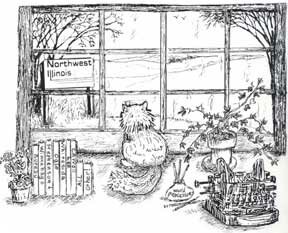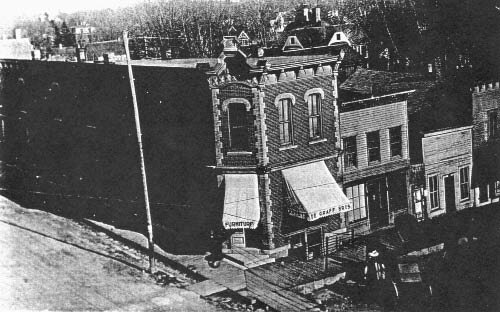
Discover rewarding casino experiences. 

Please Don't Quote Me Part III – At one time years ago “gentleman farmer” was a common description that everyone knew. Its familiar wording had to do with a fellow who probably lived in town (or in a far away town) but had a large farm which he directed (or not) from his higher place in society! |
In later years he had a driver who ushered him around the countryside in his auto. His farm was south of Lanark just west of where Benson Road meets the curve of Rt. 40, (west of that intersection), east of Chadwick a few miles. Buildings of farms of such gentlemen farmers were usually tasteful, if not showy, painted white with sometimes white fences to indicate breeds of horses few others in the neighborhood had. Their cattle and hogs were numerous, pastures greener, corn and wheat taller and a hired man who probably lived in the farmhouse. What such gentlemen farmers did everyday is beyond me but because they were important, we knew not to be anything but be impressed. “Rhodie” as he was called, lived in a tall, Gothic confection of a house, now 326 East Locust St. It had a carriage house which added to its prestige and was always passed on the way to school with a sense of awe. His widow lived there for years. It, the house, was built in the late 1860’s by a banker and remains to be restored. This came to mind in reviewing the history of “Yeager’s Corner,” the building moved three times in the course of its existence and being sold in 1915 according to a notice in the Lanark Gazette. And the fact that in 1915 the terrible plague, Foot and Mouth disease visited the county and the nation in terrible ways, Mr. Chisholm being one of those touched by its onslaught. History and plagues touch everyone from the gentleman farmer and the poor, do-it-yourself guy as it did in 1915. See how history wanders!!! If anyone else has a viewpoint here, let me know. It’s been a long, long time since thinking of the long-time owners of the “Chisholm” house so maybe it’s off-kilter. In December of 1914 the newspaper had reported that 260 head of cattle and 311 hogs had been killed at the Chisholm farm. Twenty-five men had been hired to kill and bury the carcasses ... Such crews became adept at this job. Throughout November of 1914 name followed name of those farmers whose herds had to be destroyed. At first it appeared to be north of Mt. Carroll, Lanark, then Shannon but it slowly spread. There was no medicine to cure the disease, no vaccination to prevent it. Herds from the west were being shipped in by rail (the only transport then), they infected so exposing the herds here to further sickness. The Lanark stockyards was one of the busiest in the region and from it livestock was loaded onto freight cars to be taken to Chicago. Carroll Street was sometimes called “Livestock Street” because its entire length would be filled, curb to curb, with cattle, hogs or sheep with “cowboys” heading them up, “herding them out” per Rowdie Yates; just like in Western movies, according to tales we’ve been told. With the threat of Foot and Mouth, the street was more full then usual, their owners of livestock wanting to sell before the disease took hold. It was like a frontier town in the Midwest. PDQ Me told of the Foot and Mouth disease more fully in 1989 issues, November 15 & 22, so we won’t say much more here but the trenches and pits were plenty in the burial of the diseased animals ... One could be seven feet deep, six feet wide and three hundred feet long ... Two and a half feet was allowed to hold one animal. It seemed endless. Every week there was speculation as to how to be rid of the disease ... Quick lime was poured over the carcasses ... Fumigation, keep your dogs, cats, chickens tied up and the bull penned. There was no hunting season that year as farmers didn’t want roaming dogs and hunters afoot. Authorities warned of scams, just like now, eh! It was suggested that pigeons carried hog cholera germs on their feet. Shoot them. John Morris, on the Telegraph Road, lost a herd of Red Poll selectively bred since 1888 because crows flew from the Chisholm farm a mile and three quarters away as the crow flies (!) to infect his herds. No one was exempt. But all wasn’t bad news. Excitement reigned in Argo Fay where announcement was made that a milk condensary was to be built alongside the railroad. It would be placed at the former Fred Kenyon farm. A bank and other commercial buildings would go up, too, as well as residences for employees. Basketball was being played at “the Hall,” because of course, there was no gymnasium at the school (and no athletic teams of many players either, for that matter). “The Hall” was the second floor of Flickinger’s Hardware, the south half, where once Billy Hess held sway since the beginning of Lanark and had once developed an Opera House up there to compete with the one across the street. Hess’ was called “Vineyard Hall” but heart had gone out of it after just a few years. Movies were advertised by Petey Wales who traveled the countryside showing the silent films and playing the piano accompaniment for such as “The War in Europe,” “Anthony and Cleopatra,” and the “Masked Wrestler” starring that matinee idol, Francis X. Busman ... 10¢ and 5¢ charge. They were probably at the west side Opera House. New agricultural implements were steadily improving rural life such as SILOS, a new idea for storing ensilage. Bert Irwin, Mt. Carroll, sold the “Indiana” brand, a permanent annual answer to storing green crops for livestock. 7,000 had been sold last year. $450. “Stop Digging Shocks Out of the Snow,” the slogan said.
A correction noted that it was 50 all steel railroad cars filled with gasoline at the Savanna rail yards, not five, waiting to roll on to Siberia to power up the Russian war effort. As for metal tanks, Standard Oil was complimented on erecting some with an attractive building. Where? Across from the canning factory? Why? Many short notes referring to the automobile were scattered throughout newspapers such as, no one under sixteen years of age could drive one! Hen Schoen at his harness shop advertised lap tops ... Buggy or carriage robes OR automobile knee robes! (Most cars were open to the elements.) Here was a transition. A COMPLETE change was occurring, however. That “Old Landmark,” at the northeast corner of Locust and Argyle was having its large, old timbers removed in the process of razing the building that was thought to have been erected in the 1870’s. What it had been used for, we’d like to know. Anyone? Rowland and Puterbaugh were building a large brick garage that would be devoted in all its existence (and still is), to the automobile trade ... Selling, service and repair. John Daehler has it now. It was long called the “Auto Inn.” The state highway department had also put in short section of CONCRETE ROAD at the west end of Cyclone Ridge Road. It was SOUTH main road to Mt. Carroll from Lanark. Apparently it was experimental? Advantages of concrete was often spelled out. Lots of drivers crowded the new section, it was reported weekly. Its parallel replacement, Rt. 64/52 wouldn’t come along for ten-to-twelve years, right! Six Chalmers autos arrived in town ... 2 hand-cranked, 4 self-starters, a tire pump, chains, electric lights and all for $450. City council, Freeport, advertised for a woman policeman, over 25, $75 a month pay. Even though indications of a NEW AGE were being reported, the old was still evident with Bowman’s Tie/Feed Shed saying that drive-in customers need pay only 10¢ a turn to leave your horse. No school buses yet so country students drove a pony or horse to town, sometimes in a cart ... 10¢ a day or $1.00 a month. Southeast corner, Carroll and Boyd where Paul Saidel’s sale barn stood for years, now the city maintenance shops. Horses weren’t phased out yet. The year 1915 was a time of change and the awful Foot and Mouth disease marked the calendar of everyone ever after. Summer had been cold and wet. Corn did not mature. It was still in the “milk” stage, mid-October so the canning factory was silent, only a few pumpkins were canned that fall. There was no hunting season because roaming dogs and hunters might spread the disease by foot but at the annual poultry show, English Pheasants were shown to be introduced to the area, birds and eggs, for future hunting. All dogs, cats, chickens and bulls were to be tied up or penned, too. For years Carroll Street, “Livestock Street” some called it was periodically filled with large herds of cattle or hogs or sheep waiting to be loaded on freight cars for market but on January 13, 1915 the newspaper said, “Quiet reigns on Livestock Street ... Phone messages flew to sell/ship before Tuesday Pete Horrigan, the station agent, could not order more freight cars by Monday ... “No livestock could be sent.
Then a year later a note reported, “January 6, 1916—One year ago the depot was quarantined, 129 cars had been shipped in December 1915 then 53 ‘til deadline in January 1916. Nothing after. March when the quarantine was modified. Kane County still under quarantine though it’s thought to be eradicated in the nation otherwise ... Never hope to see the likes again. What a year 1915 had been. Everyday life continued. Yeager’s Corner, a landmark, too, became “Lamoreux’s Corner” by 1919 for $2,000.00. It had a gas pump to show a transition or “adaptation,” too, from buggy to auto. Joseph Yeager would pass away in 1922 at age 88, his wife, Sarah, the previous year at 85. Quietly but energetically they helped found a town, aiding in its development. History is still being made by their 150 year old building. Little else need be said.
|





